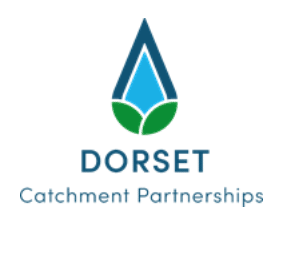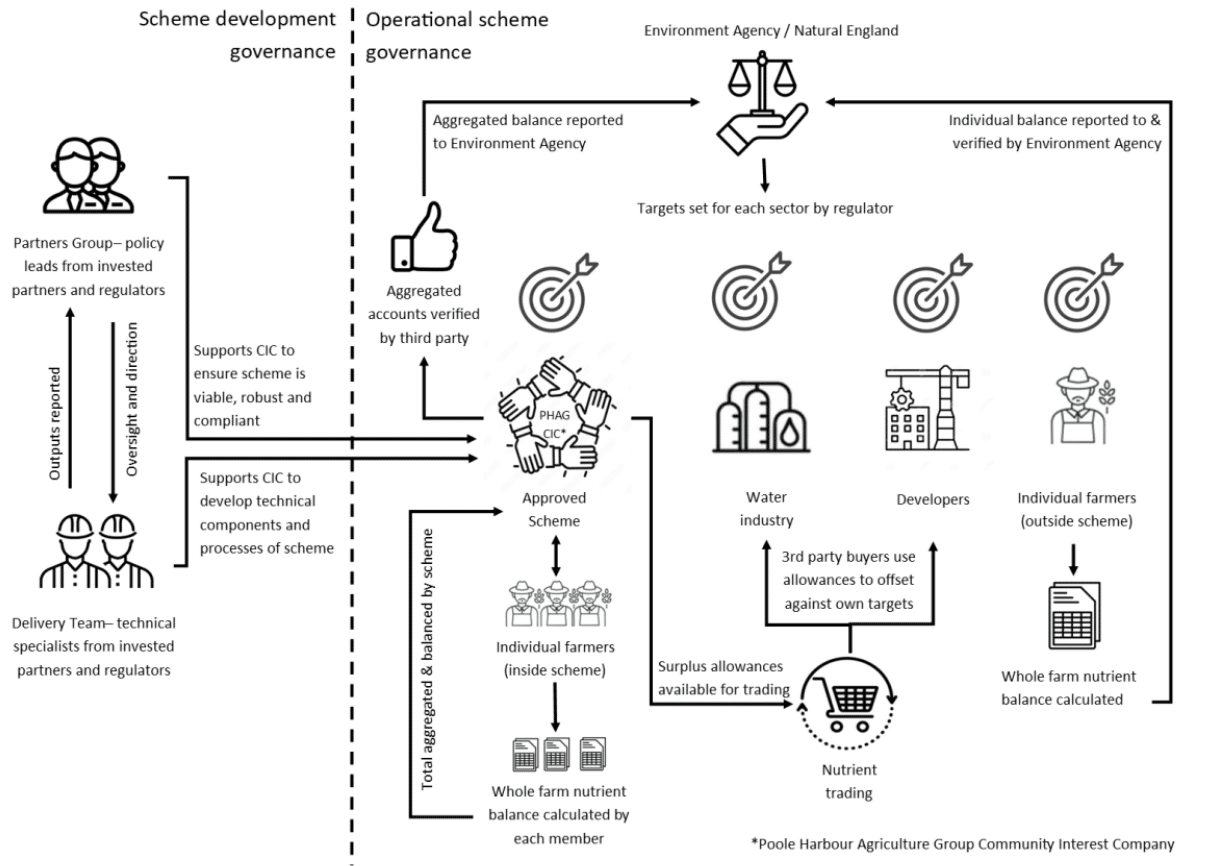Project Overview
The Poole Harbour Nutrient Management Scheme (the Scheme) aims to reduce nitrogen pollution from agricultural activity across the Poole Harbour catchment, delivered through measures such as planting cover crops and hedgerows. The Scheme requires farms to work to the glide-path nitrate reduction targets set by the Environment Agency (EA) and allows those farms to trade nitrate ‘credits’ between themselves and any excess credits to other sectors, including water companies and developers. It is a voluntary and farmer-led collective with backing from the National Farmers Union (NFU), Natural England, the Environment Agency, Wessex Water, Triodos Bank and others. In December 2021, it established a Community Interest Company to host the Scheme’s operations.
Acknowledgements
With many thanks for their time and insight on the project:
Louise Stratton, Development Manager, Poole Harbour Nutrient Management Scheme
Natalie Poulter, Dorset Catchment Partnerships Co-ordinator
Date published: 22/03/2023
Principles of Scheme governance
Louise Stratton, Development Manager of the Scheme, says that it has been governed by common principles since its inception:
- Farmer Led – The Scheme is designed for farmers, by farmers. This means it is robust, works for any farm type or size, and takes into account farming pressures at different times of the year, including the records farmers already keep.
- Science and data led – The Scheme’s design is based on up-to-date and reliable data that best captures the impact of farming on nitrate levels in the catchment and the impact of any changes in farming practices. The Group take this approach when challenging the Environment Agency’s Nitrate Leaching Tool.
- Transparency – disseminating any information on the Scheme in a digestible and understandable way. Stratton says one of the things it is keen to do is giving farmers the opportunity to know absolutely everything about the Scheme and feel part of it.
- Reinvestment into environmental outcomes – Any profits and extra funding of the Scheme gets reinvested into the farmer community, specifically to address the catchment’s water quality, for example with better monitoring capability.
Key Decision Makers
The Poole Harbour Agriculture Group Board (‘the Board’) governs the Scheme, and is its principle decision making group. It consists of five executive directors, five non-executive directors, and a Chair.
The five executive directors represent the wider farming community and three of these five were members of the original Catchment Partnership Agricultural Group that were first approached by the NFU as a ‘sounding board’ for the initial concept of the Scheme (see Initial Project Scoping). The remaining two executive directors joined in more recent years. Stratton comments that the project team wanted a sense of continuity but also realised it was important to bring in newer representatives and new ideas. Every farmer has their own social group and farmer networks to help keep the Board representative of the wider farming community in the catchment and diffuse news about the Scheme.
Along with the key directors, the Board also has five non-executive directors (NEDs) that are valued for their expertise. Two of these NEDs are also farmers and the remaining three are experts on different topics, including an agronomist who brings scientific expertise on the water quality issues of the catchment, a representative of Catchment Sensitive Farming partnership and a representative of Wessex Water. These latter two advisors were onboarded to the Board as they are deeply embedded in the catchment’s environmental activities and the farmer community.
Informally forming this Board was one of the first actions of the project in 2018, when the judicial review was issued and the concept of the Scheme was first considered. When the project team first approached three members of the Catchment Partnership Agricultural Group in 2018, there were clear intentions to form a famer-led steering group for the Scheme, though it became clear that this was not reasonable to ask so few individuals to take on this level responsibility.
Stratton comments that it would have been easy at the time to work through the existing governance structure of the Dorset Catchment Partnership, which hosted of a group of c.15 farmers to tackle local environmental issues. However, due to the specific aim of the Scheme to reduce nitrogen levels, the project team instead brought a mix of existing members of this Partnership and other members to build the initial farmer-led Board.
The project team approached its prospective directors based on their belief in the scheme, collaborative attitude and knowledge on the catchment’s environmental issues. Stratton comments: “Five years ago there was one farmer who was on the fence about joining, past experience gave him doubts over the efficacy of a Scheme like this. We agreed that he would join on a six-month trial basis, he is still a director!”
To keep this focused remit, the Board also has limited its size. In the Articles of Association of the Scheme’s CIC (see below), the Board must be at a minimum of 3 directors and a maximum of 10 directors, to prevent the project from becoming unwieldy. The Board occasionally contract in specific individuals with required skills, such as those with communication and accountancy expertise. This is done on an ad-hoc basis, and Stratton comments it is much easier to pay these individuals now that the CIC has been formed.
The Board meets once a month and uses Governors’ Virtual Office to circulate agendas, minutes, outcomes tracking and other key documents. Voting rights on any decisions are split equally, with the Chair taking the deciding vote if needed.
Development governance
To develop a scheme of this size and regulatory standing, the Scheme’s development is supported by two groups of external stakeholders. The first is a Partners Group that consists of policy and regulatory experts, such as those from the Environment Agency, Natural England and Catchment Sensitive Farming, along with the local councils. The second is a Delivery Team consisting of environmental scientists and agronomists, who focus on the technical and scientific aspects. Both these groups are fundamental to the ‘development governance’ of the Scheme, and separately met once a month with the Board and other relevant stakeholders. All organisations have two points of contact to prevent any single points of failure.
In the last quarter of 2022, it was decided to merge the meetings across the Partner Group and Delivery Team. Stratton comments that as the Scheme has become more developed, topics covered have started to overlap in these meetings and duplication was starting to occur. Stratton comments that, though this previous separation was appropriate for the Scheme, it is important for project developers to be flexible and be prepared to accept the ‘shelf life’ of certain arrangements.
The Environment Agency (EA) and Natural England have representatives across these two groups. These organisations, particularly the EA, set the boundaries by which the Scheme operates and what it needs to achieve. Stratton comments that it was clear which organisations had what responsibilities, though funding sources for these roles required more careful consideration.
Though the EA and Natural England have this key influence over the Scheme and are in continuous conversation with the Board, Stratton says that having them represented separately preserves the Scheme’s ethos of being farmer-led, and gives the directors a free space to discuss farmer-facing issues and concerns.
Modelling nature-positive agriculture and land management: Lessons in farmer-led nutrient management from Poole Harbour, University of Cambridge Institute for Sustainability Leadership (CISL) , 2022
Farmer members
Membership of the Scheme itself is open to farmers in the catchment, though due consideration was required from the project team as to how these farmers formally become members, the structure of membership fees, and how membership is terminated if by choice or non-compliance with the Scheme rules.
Farmer members are kept informed of the Scheme’s operations through its website (set up in 2021), regular bulletins, virtual and in-person meetings, and via word-of-mouth between farmers.
In 2022, the project team decided to form the structure of an Annual General Meeting (AGM) for their farmer members. These will take place at the end of December to coincide with the end of the trading year of the CIC and many farmer businesses.
The AGM will be used to report the Scheme’s operations and key measured of performance, including:
- how many farmers are members
- how much private income and investment has been generated
- ecological results from the Nitrate Leaching Tool (NLT), used to determine farmer reductions of nutrient run-off
The AGM will also be used to give decision-making powers to the wider farmer membership. While most decisions will remain with the Board, Stratton says that certain decisions, such as use of any excess funds, will be put to the members’ vote.
The first AGM has not yet been hosted, and Stratton says components of the AGM are still to be decided, such as how votes are collected, and how many votes are given to each farmer.
Legal entity structure
The project team started to debate legal entities in earnest in 2021. It was clear by this point that the Scheme needed a formal entity structure in place, to show the regulator as well as the wider farmer members that operations were being run in the correct way.
The project team undertook research into different types of legal entities and engaged with legal firm Foot Anstey, a member of the NFU’s panel of legal advisors. As many directors were members of the NFU, Foot Anstey provided this advice under the NFU membership banner which allowed a discount to the work.
The Board decided to form a Community Interest Company (CIC) limited by guarantee, with a 100% asset lock. The project team considered the overall objectives of the Scheme and its core principles: “we were essentially forming a business, but the primary objective is the catchment’s waterways and reinvestment in the community. We were also conscious of how to position the entity with farmers. A CIC with a 100% asset lock shows to all stakeholders that we’re not driven by profit, but any profits captured can be reinvested in the water quality of the catchment, for the benefit of the farming community,” comments Stratton.
Based on the above, a CIC was the clear choice to all stakeholders. Two of the Board’s directors were also directors of another CIC company, set up a year before the project. Stratton says that their experience in setting up the basic structure was extremely helpful and simplified the process significantly.
The Poole Harbour Agriculture Group CIC was formed in December 2021 at the cost of £30. Once the CIC was formed, all directors and principle team members (including Stratton) took out Directors and Officer’s Insurance, which covers them against personal liability of negligence. The project team also engaged the NFU’s panel of insurers for this.
The Board then began drafting the CIC’s Articles of Association in July 2022. Stratton comments “75% was simply getting the way we operated down on paper, the remaining 25% required more consideration. For example, how do we resolve conflicts of interest? And don’t all of the farmer directors have a conflict of interest, if these farmers are also taking part in the Scheme?” These questions were resolved with the support of Foot Anstey. The Articles of Association were signed off in December 2022 and can be found on the CIC’s Company’s House profile.
Key Learnings:
Overall, Stratton offers the below points as key learnings from developing the Scheme’s governance structure, in that it is important to:
- Keep farmers at the heart of the Scheme’s development, including in its governance and key decision-making roles.
- Be open with the potential membership about the Scheme’s development, they need to sign up in the future so bring them along with you on the journey to instil a sense of transparency.
- Have a key resource/ sufficient staffing to be the central hub and coordinate engagement activity, so no ball is dropped.
- Form a legal structure to give confidence to external and internal organisations and people that the Scheme is being developed under proper governance.
- Be flexible with supporting groups – the demands of the Scheme will change with time and supporting groups must adjust to reflect this.
- Keep the Regulator involved with the process, so that you can build trust and avoid surprises along the way. You will need to earn the recognition that you are striving to meet regulatory targets.
Sources:
- Interview with Louise Stratton, Business Development Manager of the Poole Harbour Nutrient Management Scheme, 2023
- Modelling nature-positive agriculture and land management: Lessons in farmer-led nutrient management from Poole Harbour, University of Cambridge Institute for Sustainability Leadership (CISL) , 2022


